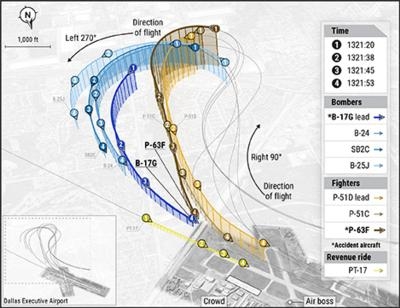Fri, Dec 13, 2024
NTSB Cites Shortcomings In Prebriefing, Oversight, And Risk Control
The National Transportation Safety Board (NTSB), in a media release on December 9, points to inadequate planning as the primary factor leading to the fatal mid-air collision of a Boeing B-17G bomber and a Bell P-63F fighter during the Wings Over Dallas air show in November 2022 at Dallas Executive Airport in Texas.

The pilot, copilot, flight engineer, and two scanners in the B-17G and the pilot of the P-63F were fatally injured and both airplanes were destroyed. Both aircraft were operated by the Commemorative Air Force (CAF).
The accident occurred as the eight airplanes in the performance were completing a repositioning turn that involved a 90-degree right turn followed by a 270-degree left turn. The P-63F was in a descending left turn when it struck the left wing of the B-17G from behind.
Using data analysis from a visibility simulation that modeled the aircraft flight paths, altitudes, and roll angles of the airplanes, NTSB investigators determined that the pilots had limited ability to see and avoid each other’s aircraft. This was attributed to the geometry of the flight paths, and obscuration of the pilots’ out-the-window views by aircraft structures.

The NTSB concluded that there was a lack of a prebriefed aircraft separation plan as well as administrative actions to address the predictable risks associated with the series of maneuvers planned for the performance.
Investigators turned up additional safety issues including the lack of a risk assessment plan, unclear communication orders, a lack of requirements for recurrent evaluation of air bosses, inadequate air show safety assessment and reporting issues within the CAF, and insufficient regulatory oversight.
The NTSB also concluded that the circumstances of the accident accentuate the inherent limitations of the see-and-avoid concept for collision avoidance, particularly in the rapidly-moving environment of an air show performance involving multiple dissimilar aircraft.
More News
From 2021: The Inside Skinny On What Being An ANN Oshkosh Stringer Is All About By ANN Senior Stringer Extraordinare, Gene Yarbrough The annual gathering at Oshkosh is a right of p>[...]
Video Showed That During The Takeoff, The Nose Baggage Door Was Open On May 10, 2025, about 0935 eastern daylight time, a Piper PA-32RT-300, N30689, was destroyed when it was invol>[...]
Get The Latest in Aviation News NOW on Instagram Are you on Instagram yet? It's been around for a few years, quietly picking up traction mostly thanks to everybody's new obsession >[...]
"I think what is key, we have offered a bonus to air traffic controllers who are eligible to retire. We are going to pay them a 20% bonus on their salary to stay longer. Don't reti>[...]
Aero Linx: Pilot Briefing The gathering, translation, interpretation, and summarization of weather and aeronautical information into a form usable by the pilot or flight supervisor>[...]
 Oshkosh Memories: An Aero-News Stringer Perspective
Oshkosh Memories: An Aero-News Stringer Perspective NTSB Prelim: Piper PA32RT
NTSB Prelim: Piper PA32RT ANN FAQ: Follow Us On Instagram!
ANN FAQ: Follow Us On Instagram! Aero-News: Quote of the Day (05.28.25)
Aero-News: Quote of the Day (05.28.25) ANN's Daily Aero-Term (05.28.25): Pilot Briefing
ANN's Daily Aero-Term (05.28.25): Pilot Briefing




